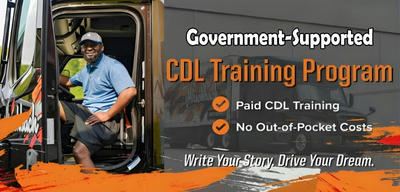🚛 Government-Funded CDL Career Driver Training Programs
📅 Training Duration: Approximately 5 to 7.5 weeks
Embarking on a commercial driving career no longer requires hefty tuition fees or accumulating debt. Government-funded CDL training programs provide the opportunity to gain professional skills with financial assistance, often covering most or all of the training expenses. These programs help individuals transition swiftly into stable, high-demand trucking careers.

Why Opt for Government-Funded CDL Training?
✅ Substantial Government Support and Financial Assistance
Due to a persistent shortage of skilled truck drivers across the United States, multiple government initiatives offer grants and funding to cover entry-level driver training (ELDT) costs. Programs like the Workforce Innovation and Opportunity Act (WIOA) provide grants for eligible applicants, including unemployed individuals or those receiving government assistance benefits. Additionally, state and local governments often provide retraining grants to help residents secure steady employment in the trucking industry.
✅ Accelerated Career Entry
Training programs are designed to be completed within 5 to 7.5 weeks, allowing students to quickly obtain their CDL and enter the workforce. This fast-track approach responds to the urgent demand for qualified drivers nationwide.
✅ Attractive Compensation & Benefits
New CDL drivers frequently receive competitive starting pay, with possibilities for bonuses and pay raises. Many employers offer comprehensive benefits packages including health, dental, vision insurance, retirement savings plans, and paid leave, ensuring financial stability and long-term security.
✅ Robust Industry Demand
The nationwide shortage of qualified truck drivers has created a resilient job market for CDL holders. This demand ensures that career opportunities are available across various regions and sectors within the transportation industry.
Who Is Eligible for These Grants?
Government-funded CDL training grants are accessible to a broad range of candidates, including:
| Category | Description |
|---|---|
| Unemployed or Laid-off | Individuals currently out of work seeking new career pathways through federally supported programs. |
| Veterans | Military veterans may qualify for training funding via the Post 9/11 GI Bill® and Veterans Rapid Retraining Assistance Program (VRRAP). |
| Individuals Receiving Government Assistance | Those on SNAP benefits or unemployment insurance may be eligible for WIOA-funded CDL training grants. |
| Injured Workers | Vocational rehabilitation programs often provide funding for CDL training to support career transitions. |
| Native American Students | Tribal education scholarships may be available through tribal councils or the Bureau of Indian Affairs. |
Types of CDL Training Grants Available
WIOA Funding: Supports unemployed or underemployed individuals in gaining skills through CDL courses, often covering tuition and related costs.
State and Local Grants: Many states offer specialized grants targeting residents for CDL retraining, including programs like Missouri’s SkillUp initiative and farmworker grants.
Vocational Rehabilitation Grants: Designed for workers recovering from injuries or disabilities, offering funding to help reenter the workforce.
Veterans Benefits: The Post 9/11 GI Bill® and VRRAP provide tuition assistance and stipends for veterans pursuing CDL training.
Tribal Scholarships: Financial aid offered through tribal entities to support Native American students’ education in commercial driving.
CDL Training Scholarships: Various foundations and associations provide scholarships that may be combined with grants to fully fund training programs.
How to Apply for CDL Training Grants
Research Available Grants: Identify grants that match personal eligibility criteria and take note of application deadlines.
Complete Application Forms: Fill out required paperwork accurately, providing supporting documentation such as proof of unemployment or military service.
Submit Applications Timely: Ensure all materials are submitted before deadline dates.
Follow Up: Maintain communication with grant administrators for updates and additional requirements.
Enroll in Accredited CDL Training: Choose reputable training providers that comply with federal Entry-Level Driver Training (ELDT) standards.
Maximizing the Benefits of CDL Training Grants
Enroll in comprehensive CDL programs offering both classroom instruction and behind-the-wheel experience.
Commit fully to the training schedule and participate actively to build solid driving skills.
Adhere to safety practices learned during training to prepare for a successful career.
Network with experienced drivers and industry professionals to gain insights and mentorship.
Strategically plan career progression, including preferred driving routes and employment opportunities.
Manage finances prudently, budgeting for licensing fees, medical exams, and other related costs beyond training.
CDL Program Funding and Support: National Overview
In fiscal year 2024, the Commercial Driver’s License Program Implementation (CDLPI) Grant Program awarded $55.1 million through 41 grants to 30 state agencies and several national organizations. These grants support state driver licensing agencies and other entities that enhance compliance with federal CDL regulations, contributing to highway safety and the integrity of CDL issuance across the country.
Applicants for CDLPI grants include state agencies responsible for driver licensing and organizations working on projects to improve CDL program compliance and enforcement. The program underscores the principle of “One Driver. One License. One Record.” to ensure only qualified drivers receive commercial licenses.
Staying Informed and Supported
Career specialists are available nationwide to assist prospective CDL drivers in identifying funding opportunities tailored to their circumstances. They provide guidance on eligibility and application processes, helping maximize the chances of securing grant funding. Applicants are encouraged to explore resources from state workforce centers, veterans’ affairs offices, and tribal education programs.
Embarking on a CDL career through government-funded training programs offers a financially accessible, efficient pathway into a stable and rewarding profession. With growing industry demand and robust support, aspiring commercial drivers can build strong futures behind the wheel.
